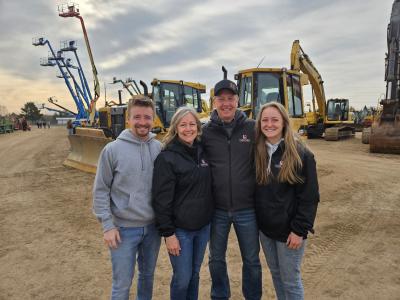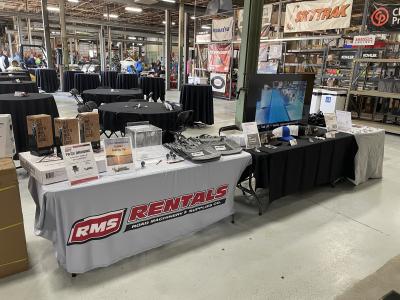The demolition of the 5,078 ft. (157.8 m) long eight-lane Innerbelt Bridge (built in 1959, traffic both directions) in Cleveland, Ohio, began in early January and is expected to be completed by the end of August.
A three-year construction project will then be set in motion to build the eastbound (five-lane) side of the George V. Voinovich Bridge (GVV) that is being undertaken by Trumbull-Great Lakes-Ruhlin (TGR) — a Joint-Venture — for the Ohio Department of Transportation (ODOT).
Construction on the viaduct began on July 21 and work on the west approach started last spring.
The new westbound bridge, which is currently handling traffic in both directions, was renamed at its opening in 2013 to honor George V. Voinovich, a former mayor of Cleveland, governor of Ohio and a United States Senator from 1999-2011.
The $273 million eastbound bridge, under design by URS Corporation, is intended to be a sister bridge to the westbound bridge, a $293 million project that was built by Walsh Construction. Both projects were let as design-build projects.
“When both are completed they will look the same, but ODOT allowed some changes to the structural system provided the basic shape of the delta girder superstructure and the piers was maintained,” said Steve Stroh, URS’s chief bridge engineer. “The joint-venture team took advantage of this opportunity to propose a design that simplifies fabrication and erection. Rather than providing an integrated delta girder shape, the TGR design separates the delta girder from the plate girder portion of the superstructure, and places bearings between these two elements.
“This results in an independent delta girder that is post-tensioned to the pier, and has a separate tension tie across the top,” he added. “Bearings are placed atop this delta girder to support a ’conventional’ plate girder superstructure.”
Nick Graczyk, project engineer of Trumbull Corp., said that the new design eliminates the need for complex temporary works to support and position the legs of the delta frame during steel erection.
“This will prove to be a more economical design with cost savings from the design, fabrication and erection of the temporary works, as well as expediting the structural steel erection schedule,” he said. “The new design also simplifies the interface between the delta leg and the plate girder superstructure. It eliminates the complex fixed connection of the westbound bridge which will simplify steel erection and fabrication.
“It will also eliminate the ’oversized’ field sections that were required for the westbound bridge,” he added. “Each section of the eastbound bridge will be able to be transported in an upright position, which is a more ’conventional’ delivery method. This will simplify the handling of the sections in the shop and on site, as well as save in delivery cost.”
Asked about the challenges that are anticipated, Stroh points out that the viaduct of the GVV Bridge is a continuous superstructure over its nearly 3,000 ft. (914 m) length, with no intermediate expansion joints.
“Its superstructure is comprised of a girder and sub stringer floor system, and the delta girder supporting elements,” he said. “The analysis must be a fully integrated 3D model that accommodates the entire 3,000 foot bridge length. This places special challenges on the computer modeling and analysis of the structure. URS is utilizing LARSA software for this analysis and has developed a detailed computer model that accounts for the complex bridge geometry and integrates loading, and design/code checking capabilities into a single model.”
The crews from the joint-venture also have determined some of the challenges they will have to overcome, including the soil stability of the west slope during demolition of the existing bridge and construction of the new bridge.
“Detailed analyses and monitoring will be performed to check each of the loading conditions (earth and equipment loads) that the slope will encounter during demolition and construction,” said Graczyk. “The pile driving operation for the new foundations of the bridge piers also will present challenges during construction. The design specifies the largest H-pile section rolled in the industry [HP18x204] at a total length of 180 feet. TGR will use a 300T crawler crane [Manitowoc 2250 Series III] to suspend the leads and hydraulic hammer for the initial pile drive. A second 300T crawler crane [also a Manitowoc] will be used to suspend the leads and diesel hammer [D160-42] for the final drive.”
In addition to the span being impacted by the geographic constraints of the Cuyahoga River and west slope, the project will have to deal with issues posed by the operations of the CSX railroad, Norfolk Southern elevated train trestle, Greater Cleveland Regional Transit Authority rail, and others which present significant challenges for steel erection. TGR will use two 300T crawler cranes (also Manitowoc 2250 Series III) to erect the structural steel.
“Another significant challenge will be the erection of the delta ’knuckle,’” said Graczyk, “which will be grouted and post tensioned to the pier caps.”
The river poses its own unique challenges, but TGR, via serious pre-planning, will mount a 300T crawler crane (Manitowoc 2250 Series III) on a barge to erect the structural steel spanning the river.
“In an effort to offset the reduced lift capacity of the crane on the barge, additional field splices were added to the superstructure plate girders to reduce the weight of the lifts from the water,” said Graczyk. “The delta legs of the piers adjacent to the river, that cantilever over the river, will be erected with the crane mounted on the barge while a second 300T crawler on land will erect the opposite delta leg, as well as the permanent tension tie.
“Once the deltas are constructed atop the piers,” he added, “shorter plate girder sections will be cantilevered out into the river to adjust the geometry of the structure and to provide a more feasible gap to erect the closure sections. The crane mounted on the barge will complete the span over the river by erecting the ’drop-in’ sections.”
The construction schedule was developed at an early stage during the estimate based on past experience of bridge projects.
“Construction of the pier foundations [i.e. pile driving] begin in mid-July, with substantial completion of the bridge scheduled for the fall of 2016,” said Graczyk. Primavera P6 scheduling software is being utilized by TGR to monitor the progress of the work.”
The project will require a fair amount of cranes to construct the bridge piers and deck — crawler cranes ranging from 150 to 275 tons (136 to 249 t). Equipment on the job will include Manitowoc 2250 and Manitowoc 888 cranes, a Terex RT 780 crane, a Komatsu P220 tracked excavator, Caterpillar tracked excavators — 330, 336 and 360s, and John Deere dozers — 650 and 850s. The equipment is coming from all three of the joint venture compa-nies. As well, an APE D160 hammer was purchased specifically for use in this project.
When construction peaks, there will be 150 to 200 workers on site. This number does not include the necessary support staff, quality assurance, designers and others working on the project, which if totaled, would bring the number closer to 500. All three companies which make up Trumbull-Great Lakes-Ruhlin have contributed crews to the project.
Major subcontractors to be brought in for the project include: The Joseph B. Fay Company for demolition, Controlled Demolition Inc. for the explosive demolition portion, Amelie Construction & Supply to finish and install steel in various sections of the structure, Foundation Steel to furnish and install rebar, The Shelly Company for asphalt paving and Miller Cable for electrical work including the aesthetic lighting.
Scheduling for the project is in the final stages.
“Prior to the start of any new activity on the job a pre-activity meeting is held which gathers all involved to discuss that particular aspect of the project,” said Karen Lenehan, public information consultant to TGR. “Weekly meetings are held to keep schedules co-ordinated. The schedule has been developed so it is sequenced for year-round work. Weather sensitive activities like pouring decks and painting is scheduled for warmer months and structural steel erection and pile driving can be done through the winter months.”
Temporary offices have been set up close to the job site which house both TGR and ODOT officials.
“It is a set up that allows easy and constant communication between TGR, URS, Parsons Brinkerhoff, the quality assurance partner on the job, and ODOT,” said Lenehan.
The new bridge will require a vast amount of material, including: 11 million lbs. (5 million kg) of H pile, 37 million lbs. (16.8 million kg) of structural steel, 11 million lbs. of rebar, and 7,400 trucks full of concrete.
“Timely, staged deliveries are scheduled, so as materials are trucked in they can be used di-rectly from the truck,” said Lenehan. “Some of the specialty items, such as ornamental railings, will be stored at a location just off the job site. This site houses field trailers and offers space for equipment storage as well. Piling was ordered in March of 2014 and structural steel has a lead time of 10 to 12 months, so it will be ordered and delivered over a course of nine months, with delivery to begin in 2015.”
Many barges will be employed on the project and a crane will be used to load them. No temporary road will be required to support the construction.
The joint-venture will have one master mechanic on site, and space has been set aside for repair facilities, storage sheds for spare parts, temporary offices, fueling stations and depots for oils.
Today's top stories















